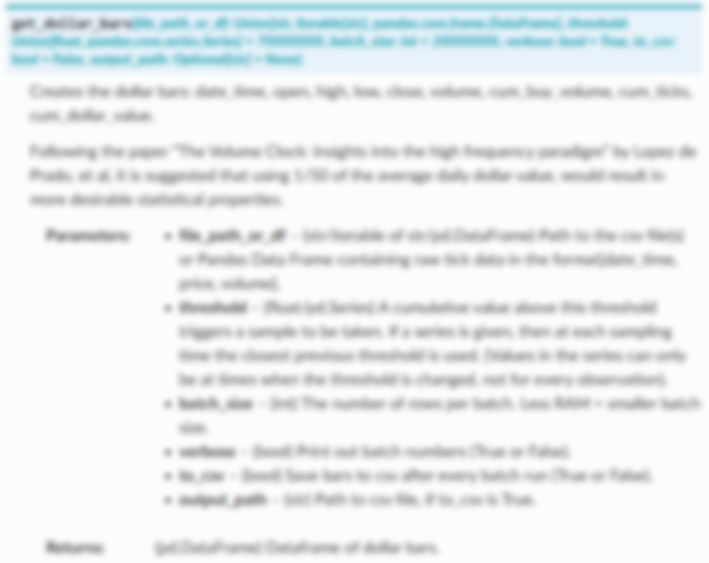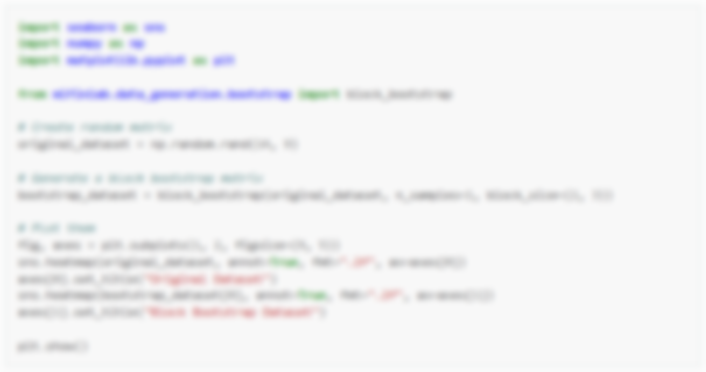Volatility Estimators¶
In finance, volatility (usually denoted by \(\sigma\)) is the degree of variation of a trading price series over time, usually measured by the standard deviation of logarithmic returns. Volatility is an essential metric for trading, including short-term day trading and swings trading, in which the primary focus is on daily and weekly price movements. In fact, volatility estimates can provide a profit opportunity by identifying swings and helping with bet and portfolio sizing. In order to find an edge in option trading, we need an estimate of future realized volatility to trade against that implied by the options. There are two types of volatility, historic volatility and implied volatility. Historic volatility measures a time series of past market prices, whereas implied volatility looks forward in time, being derived from the market price of a market-traded derivative (in particular, an option). But before we can forecast future volatility we need to be able to measure what it has been in the past thanks to different historic volatility estimators. These methods use some or all of the usually available daily prices that characterize a traded security: open (O), high (H), low (L), and close (C). The most common method used to estimate the historical volatility is the close-to-close method. In this approach, the historical volatility is defined as either the annualized variance or standard deviation of log returns.
where \(x_{\mathrm{i}}\) are the logarithmic returns, \(\bar{x}\) is the mean return in the sample and N is the sample size.
Many different methods have been developed to estimate the historical volatility.
Note
Underlying Literature
- The following sources elaborate extensively on the topic:
Volatility trading, Chapter 2 by Euan Sinclair.
Advances in Financial Machine Learning, Chapter 19 by Marcos Lopez de Prado.
Parkinson Estimator¶
In 1980, Parkinson introduced the first advanced volatility estimator based only on high and low prices (HL), which can be daily, weekly, monthly, or other. Parkinson estimator is five times more efficient than the close-to-close volatility estimator as it would need fewer time periods to converge to the true volatility as it uses two prices from each period instead of just one as with the close-to-close estimator. A slightly different versions of the estimator are present in the literature. According to Sinclair, Parkinson estimator is defined as:
where \(h_{\mathrm{i}}\) is the high price in the trading period and \(l_{\mathrm{i}}\) is the low price.
According to De Prado, the estimator can be defined as:
where \(k_{1}=4 \log [2]\), \(H_{\mathrm{t}}\) is the high price for bar t, and \(L_{\mathrm{t}}\) is the low price for bar t.
The limitation of this estimator is that prices are only sampled discretely because markets are only open for part of the day. This means that the unobservable true price may not make a high or a low when we can actually measure it, hence Parkison estimator will systematically underestimate volatility.
Implementation¶
The following function implemented in MlFinLab can be used to derive Parkinson volatility estimator.
Garman-Klass Estimator¶
Garman and Klass proposed in 1980 a volatility estimator that aimed to extend Parkinson’s volatility by using not only the high and low but also the opening and closing prices. During their research, Garman and Klass realized that markets are most active during the opening and closing of a trading session. Furthermore, they assumed the price change process is a geometric Brownian motion with continuous diffusion. Given these assumptions, Garman-Klass estimator is defined as:
where \(h_{\mathrm{i}}\) is the high price, \(l_{\mathrm{i}}\) is the low price and \(c_{\mathrm{i}}\) is the closing price in the trading period.
The Garman-Klass volatility estimator tries to make the best use of the commonly available price information and as such is up to eight time more efficient than the close-to-close volatility estimator. However, like Parkinson estimator, the Garman Klass estimator also provides a biased estimate of volatility as its discrete sampling doesn’t allow to take into account opening jumps in price and trend movements.
Implementation¶
The following function implemented in MlFinLab can be used to derive Garman-Klass volatility estimator.
Rogers-Satchell Estimator¶
Volatility estimators like Parkinson’s and Garman-Klass have been shown to be more efficient than the close-to-close volatility estimator. However, these estimators assume that the underlying process follows a geometric Brownian motion with zero drift, which isn’t always the case in real markets. Particularly, during periods when the asset trends strongly, these estimators then overestimate volatility. From this observation, Rogers and Satchell proposed in 1991 a new estimator that allows for non zero drift:
where \(h_{\mathrm{i}}\) is the high price, \(l_{\mathrm{i}}\) is the low price, \(o_{\mathrm{i}}\) is the opening price and \(c_{\mathrm{i}}\) is the closing price in the trading period.
The main advantage of the Rogers-Satchell estimator is that it provides better volatility estimates during periods when the asset trends strongly. The main limitation of this estimator is the discrete sampling that doesn’t allow to take into account opening jumps in price.
Implementation¶
The following function implemented in MlFinLab can be used to derive Rogers-Satchell volatility estimator.
Yang-Zhang Estimator¶
Yang Zhang estimator is a volatility estimator that allows to overcome the main limitation of Parkinson’s, Garman-Klass’s and Rogers-Satchell’s estimators, that being the existing bias due to the discrete sampling as it doesn’t account for the opening jumps in price. In fact, Yang Zhang devised in 2000 an estimator that combines the classical and Rogers-Satchell estimator, showing that it has the minimum variance and is both unbiased and independent of process drift and opening gaps.
where \(h_{\mathrm{i}}\) is the high price, \(l_{\mathrm{i}}\) is the low price, \(o_{\mathrm{i}}\) is the opening price and \(c_{\mathrm{i}}\) is the closing price in the trading period.
The efficiency of Yang-Zhang estimator has a peak value of 14, meaning that using only two days’ data for this estimator gives the same accuracy as the classical estimator using three week’s data. However, where the process is dominated by opening jumps the efficiency reduces to almost one, which means there is no improvement over the classical clos-to-close estimator.
Implementation¶
The following function implemented in MlFinLab can be used to derive Yang-Zhang volatility estimator.
Corwin-Shultz Estimator¶
Corwin-Schultz is a bid-ask spread estimator from daily high and low prices to measure the bid-ask spread of shares, using the formula:
where
The estimator is based on the assumption that daily high prices are typically buyer initiated and low prices are seller initiated, and therefore the ratio of high-to-low prices for a day reflects both the fundamental volatility of stock and its bid-ask spread. Furthermore, it assumes that the volatility component of the high-to-low price ratio increases proportionately with the length of trading interval whereas the component due to bid-ask spreads does not. Corwin-Schultz estimation bias and the frequency of negative estimates increase in liquid assets or when price volatility is high.
Implementation¶
The following function implemented in MlFinLab can be used to derive Corwin-Shultz estimator.
Cho-Frees Estimator¶
Cho Frees estimator is a volatility estimator which eliminates, at least asymptotically, the biases that are caused by the discreteness of observed stock prices. Assuming that the observed prices are continuously monitored, using the notion of how quickly the price changes rather than how much the price changes an estimator is constructed:
where \(\delta=\log (1+d)\) being d a known constant (1/8 for the New York Stock Exchange for example), \(\hat{\mu}=\bar{\tau}_{n}^{-1} \log \left(P\left(\tau_{n}\right)\right)\) and \(\bar{\tau}_{n}=\tau_{n} / n\).
It is shown that this estimator has desirable asymptotic properties, including consistency and normality. Also, it outperforms natural estimators for low and middle-priced stocks. Further, simulation studies demonstrate that the proposed estimator is robust to certain misspecifications in measuring the time between price changes.
Implementation¶
The following function implemented in MlFinLab can be used to derive Cho-Frees estimator.
First Exit Time Estimator¶
The first exit times estimator is a volatility estimator that derives from Cho Frees estimator, and as the latter, it considers how quickly the price changes rather than how much the price changes. The estimator is constructed by considering a price corridor, \(\Delta\) up and \(\Delta\) down from the initial spot price. Each time the upper or lower barrier of the corridor is touched, the barrier is reset around the current price, and the times to reach the barrier noted form a sequence of exit times from which the volatility is estimated using the formula:
where \(E[\tau]\) is the sample mean of the hitting times after n observations The sample volatility derived with this formula is biased unless n is large, therefore we can derive the unbiased volatility by considering this relationship between the two:
where \(E[f(\bar{\tau})]\) is the unbiased volatility.
This estimator assumes Brownian motion for the log-price process and a negligible drift in prices, hence its estimates may be biased in periods of time during which prices trends significantly.
Implementation¶
The following function implemented in MlFinLab can be used to derive the first exit times estimator.
Research Notebook¶
The following research notebook can be used to better understand the volatility estimators.












